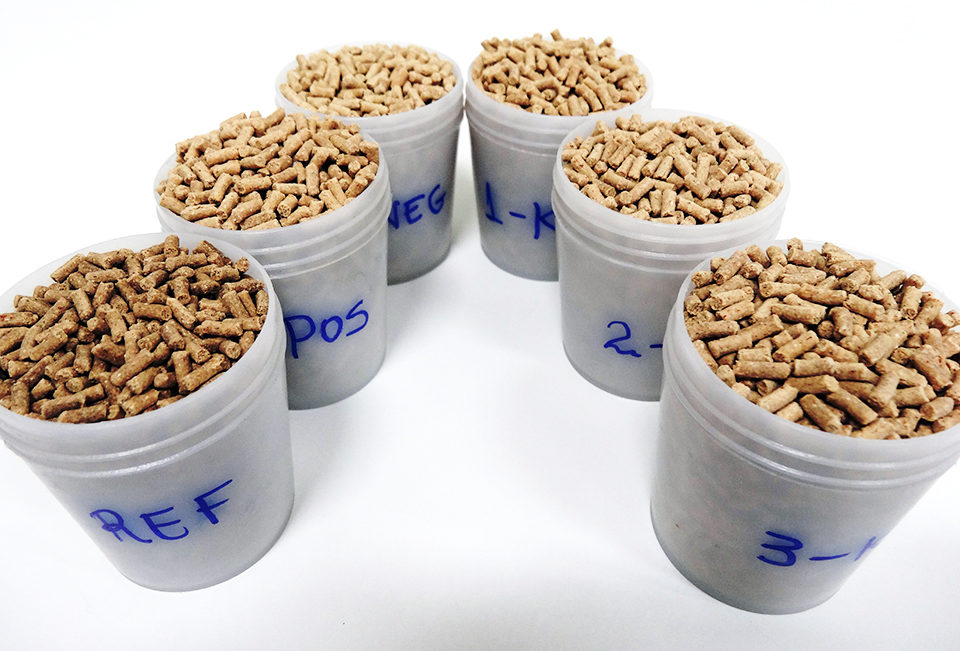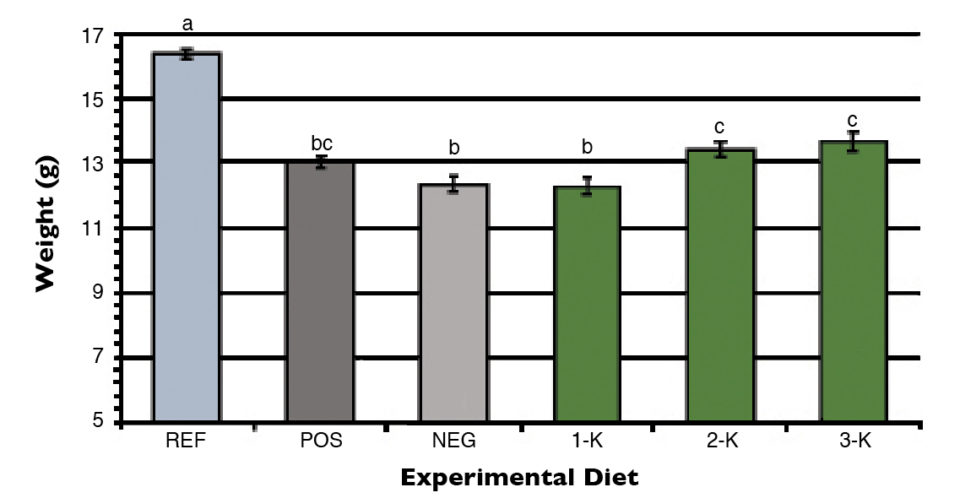Supplementation results in improved yield, growth and survival

Cholesterol is considered an essential nutrient for penaeid shrimp that acts as a component of cell membranes and a metabolic precursor of steroid and molting hormones. Deficiency of cholesterol in shrimp diets can result in slower growth and higher mortality rates characterized by incomplete ecdysis. Cholesterol requirements in marine shrimp seem to be species-specific. Reported requirements range from less than 0.1 to as much as 1.0 percent of the diet.
In a 2000 report, Hui Gong and co-workers demonstrated an interaction between dietary cholesterol and phospholipids for Pacific white shrimp, Litopenaeus vannamei. Cholesterol requirements in diets containing 1.5 and 3.0 percent supplemental phospholipids were reduced to 0.14 and 0.13 percent, respectively, compared to 0.35 percent in the absence of supplemental phospholipids.
Cholesterol
Cholesterol and phospholipids may be present in feedstuffs such as rendered animal by-products and marine protein sources used in shrimp feeds. However, sterol supplements are often used to fully meet shrimp requirements and assure proper growth performance and survival.
There are few suppliers of cholesterol worldwide, and prices have skyrocketed in recent years. Cholesterol is extracted from wool grease obtained from farmed sheep, mainly in New Zealand. Therefore, prices can fluctuate depending on the use of wool by the clothing industry.
Krill meal
Krill meal is one of the few commercially available protein ingredients with a high fat content of 18 to 28 percent lipid that can deliver high levels of the unsaturated fatty acids docosahexaenoic acid and eicosapentaenoic acid (present at 5.5 percent of the meal), cholesterol (0.6 mg/kg) and phospholipids (40 percent or more of lipid content) at low dietary inclusion levels.
A study by the authors aimed to investigate the minimum dietary inclusion of krill meal able to replace a cholesterol supplement with 91 percent or more active cholesterol in growout diets for juvenile Litopenaeus vannamei shrimp.
Study setup
The study was carried out at the LABOMAR aquaculture facilities in north-eastern Brazil. Six diets were designed (Table 1): a reference diet (REF) formulated to contain high levels of fishmeal, combined with cholesterol supplementation and 2 percent krill meal; a positive control diet (POS) containing low levels of fishmeal combined with cholesterol supplementation, but no krill meal; a negative control diet (NEG) designed to be nearly equivalent to POS, but lacking cholesterol supplementation; and three experimental diets formulated to contain no cholesterol supplementation with dietary levels of krill meal at 1, 2 or 3 percent of the diets (1-K, 2-K and 3-K).
Nunes, Composition of experimental diets, Table 1
| Ingredient | Dietary Inclusion (%) REF | Dietary Inclusion (%) POS | Dietary Inclusion (%) NEG | Dietary Inclusion (%) 1-K | Dietary Inclusion (%) 2-K | Dietary Inclusion (%) 3-K |
|---|---|---|---|---|---|---|
| Soybean meal | 32.68 | 48.15 | 48.15 | 48.74 | 49.22 | 49.69 |
| Wheat flour | 30.35 | 27.00 | 27.00 | 27.00 | 27.00 | 27.00 |
| Salmon by-product meal | 18.00 | 5.00 | 5.00 | 5.00 | 5.00 | 5.00 |
| Soy protein concentrate | 5.00 | 10.18 | 10.18 | 8.84 | 7.58 | 6.33 |
| Wheat red dog flour | 4.00 | 0 | 0 | 0 | 0 | 0 |
| Dicalcium phosphate | 1.79 | 2.03 | 2.03 | 2.00 | 2.00 | 2.00 |
| Salmon oil | 2.48 | 2.00 | 2.00 | 2.00 | 2.00 | 2.00 |
| Soybean oil | 0 | 1.65 | 1.74 | 1.62 | 1.51 | 1.40 |
| Krill meal | 2.00 | 0 | 0 | 1.00 | 2.00 | 3.00 |
| Soybean lecithin | 1.67 | 1.83 | 1.83 | 1.74 | 1.64 | 1.55 |
| Mineral-vitamin premix | 1.00 | 1.00 | 1.00 | 1.00 | 1.00 | 1.00 |
| Synthetic binder | 0.50 | 0.50 | 0.50 | 0.50 | 0.50 | 0.50 |
| Choline chloride, 60% | 0.33 | 0.34 | 0.34 | 0.33 | 0.33 | 0.32 |
| D.L.-methionine | 0.08 | 0.19 | 0.19 | 0.19 | 0.18 | 0.17 |
| Cholesterol, 91% | 0.08 | 0.09 | 0 | 0 | 0 | 0 |
| Vitamin C | 0.04 | 0.04 | 0.04 | 0.04 | 0.04 | 0.04 |
| Formula cost (U.S. $/mt)* | $1,017 | $837 | $744 | $758 | $772 | $786 |
| Nutrient content (%, dry matter basis) ** | ||||||
| Crude protein | 35.00 | 35.00 | 35.00 | 35.00 | 35.00 | 35.00 |
| Methionine | 0.70 | 0.70 | 0.70 | 0.70 | 0.70 | 0.70 |
| Methionine + cystine | 1.08 | 1.01 | 1.01 | 1.02 | 1.03 | 1.03 |
| Lysine | 2.02 | 1.98 | 1.98 | 1.98 | 1.99 | 1.99 |
| Fat | 8.00 | 8.00 | 8.00 | 8.00 | 8.00 | 8.00 |
| Highly unsaturated fatty acids | 0.50 | 0.36 | 0.36 | 0.39 | 0.42 | 0.44 |
** Projected/formulated values
A total of 2,350 shrimp with body weights of 2.00 ± 0.14 g were stocked at 45 shrimp/tank in 30 clearwater tanks of 0.5-m3 volume with continuous water filtration and recirculation. Five replicate tanks were assigned for each dietary treatment. Shrimp were fed four times daily to satiation for 69 days.

Results
Shrimp performance was significantly influenced by dietary treatment. Higher nutrient levels in the reference diet resulted in improved shrimp yield, weekly growth and final body weight at harvest (Table 2 and Figure 1). The lack of supplemental cholesterol in the NEG control diet caused a deleterious effect on final shrimp survival. Supplementation with 3.0 percent krill meal counteracted this effect, raising final shrimp survival from 73.8 ± 10.8 percent for the NEG treatment to 81.5 ± 11.0 percent.
| Dietary Treatment | Final Survival (%) | Gained Yield (g/m2) | Feed Intake (g/shrimp) | Feed-Conversion Ratio | Growth (g/week) |
|---|---|---|---|---|---|
| REF | 97.8 ± 11.2a | 1,106 ± 28a | 23.4 ± 0.5a | 1.67 ± 0.03a | 1.46 ± 0.10a |
| POS | 80.9 ± 9.0b | 674 ± 110b | 21.5 ± 0.9b | 2.56 ± 0.34b | 1.12 ± 0.07b |
| NEG | 73.8 ± 10.8b | 564 ± 123b | 20.8 ± 0.9b | 3.03 ± 0.71b | 1.05 ± 0.12b |
| 1-K | 79.3 ± 6.8b | 611 ± 82b | 20.8 ± 0.2b | 2.71 ± 0.34b | 1.04 ± 0.04b |
| 2-K | 76.3 ± 1.3b | 650 ± 8b | 21.2 ± 0.2b | 2.57 ± 0.01ab | 1.16 ± 0.03b |
| 3-K | 81.5 ± 11.0ab | 721 ± 131b | 22.1 ± 0.8ab | 2.47 ± 0.39ab | 1.18 ± 0.09b |
| ANOVA P value | 0.004 | < 0.0001 | < 0.0001 | 0.002 | < 0.0001 |
The use of krill meal at 3 percent combined with 5 percent salmon meal was able to enhance feed intake at levels comparable to the REF diet with 18 percent salmon meal and 2 percent krill meal. While feed conversion was better for shrimp fed the REF diet, it was not significantly different when diets were supplemented with 2 or 3 percent krill meal. On the other hand, the lack of supplemental cholesterol depreciated shrimp body weight, which was only recovered when krill meal was supplemented at 2 or 3 percent.
(Editor’s Note: This article was originally published in the July/August 2015 print edition of the Global Aquaculture Advocate.)
Authors
-
Alberto J. P. Nunes, Ph.D.
LABOMAR Instituto de Ciências do Mar
Av. da Abolição, 3207
Meireles, Fortaleza, Ceará
CEP 60165-081 Brazil[114,98,46,99,102,117,64,115,101,110,117,110,46,111,116,114,101,98,108,97]
-
Felipe Nobre Façanha, M.S.
LABOMAR Instituto de Ciências do Mar
Av. da Abolição, 3207
Meireles, Fortaleza, Ceará
CEP 60165-081 Brazil -
Dr. Hassan Sabry-Neto
LABOMAR Instituto de Ciências do Mar
Av. da Abolição, 3207
Meireles, Fortaleza, Ceará
CEP 60165-081 Brazil
Related Posts

Aquafeeds
Krill meal performs well in shrimp feed experiments
A study of experimental diets for juvenile shrimp showed a halving of fishmeal usage. Limited inclusion of krill meal offset other expensive ingredients.

Aquafeeds
Aquaculture Exchange: Andrew Jackson, IFFO
Aquaculture remains dependent on fishmeal and fish oil, crucial marine ingredients in aquafeeds, particularly at key life stages. Andrew Jackson, technical director at IFFO and one of the world’s foremost fishmeal experts, tells the Advocate that the two industries can coexist well into the future if properly managed.

Aquafeeds
The importance of carotenoids in aquafeeds
Carotenoids are important pigments that contribute characteristic quality criteria for the marketing of aquaculture products. Aquatic animals cannot biosynthesize carotenoids de novo, hence their inclusion in aquafeeds is important because they are associated with various metabolic functions.

Aquafeeds
Alternative feed ingredient universe to convene at F3 meeting
What started out as a simple yet ambitious contest to drive innovation in the aquafeed sector has evolved into a fully global competition – and collaboration – amongst ingredient suppliers and feed manufacturers.


